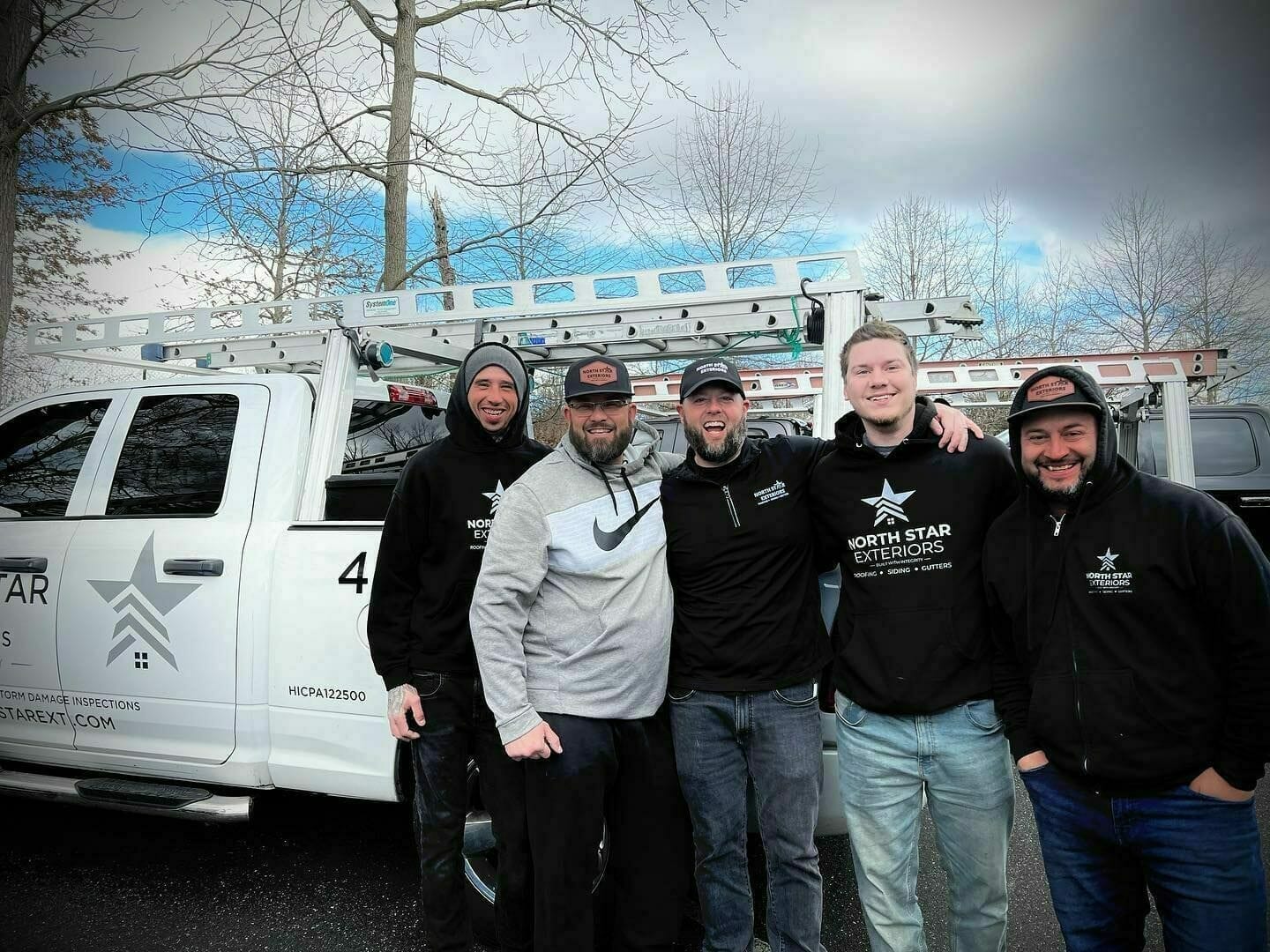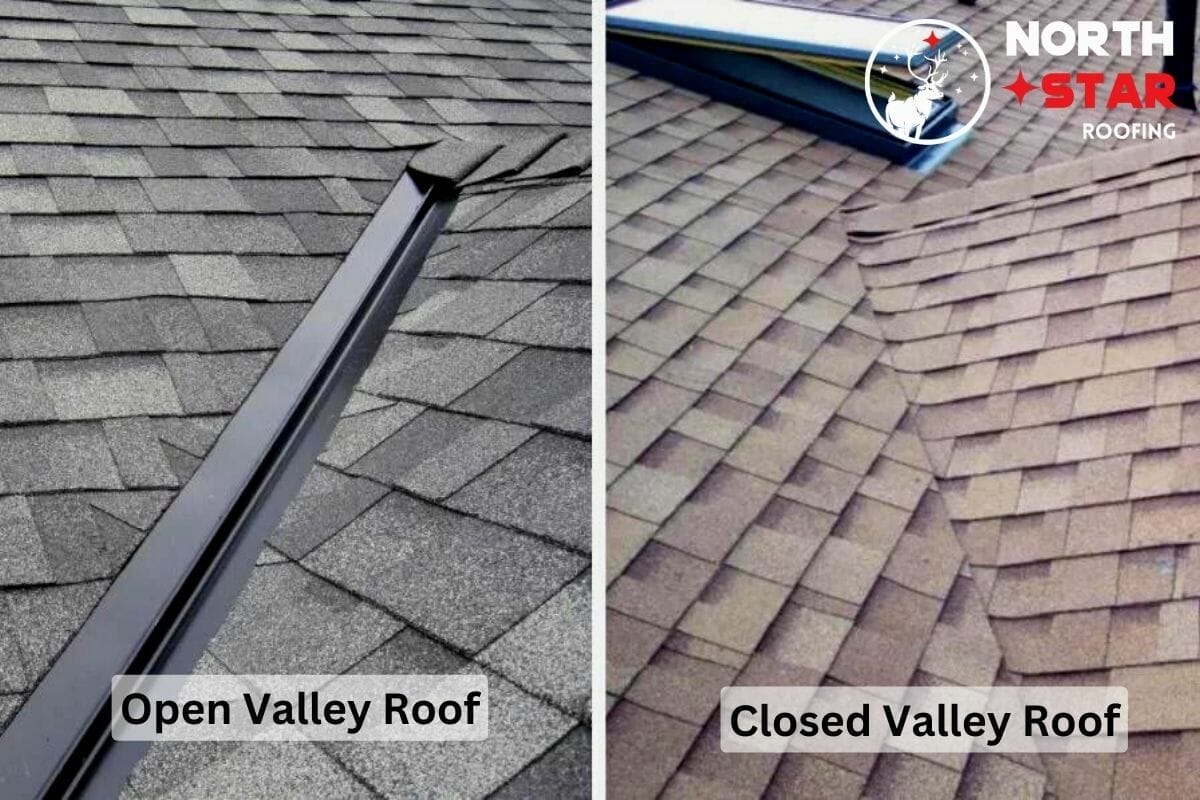Roof valleys may seem like a small design element, but they’re quite important and homeowners should understand the pros and cons of both open and closed valley roofs. Luckily, this blog should help you make a more informed and personalized decision for your home.
At North Star Roofing, we’re here to cool down the long-standing debate on open vs closed valley roofs. We’ve cut through the clutter and simplified everything, from benefits and drawbacks to materials and designs. This blog can be one of the most helpful resources for homeowners who need a comprehensive comparison and expert analysis.
So let’s dig deeper into the world of open and closed roof valleys and find out which one you want!
Understanding Closed Valley Roofs
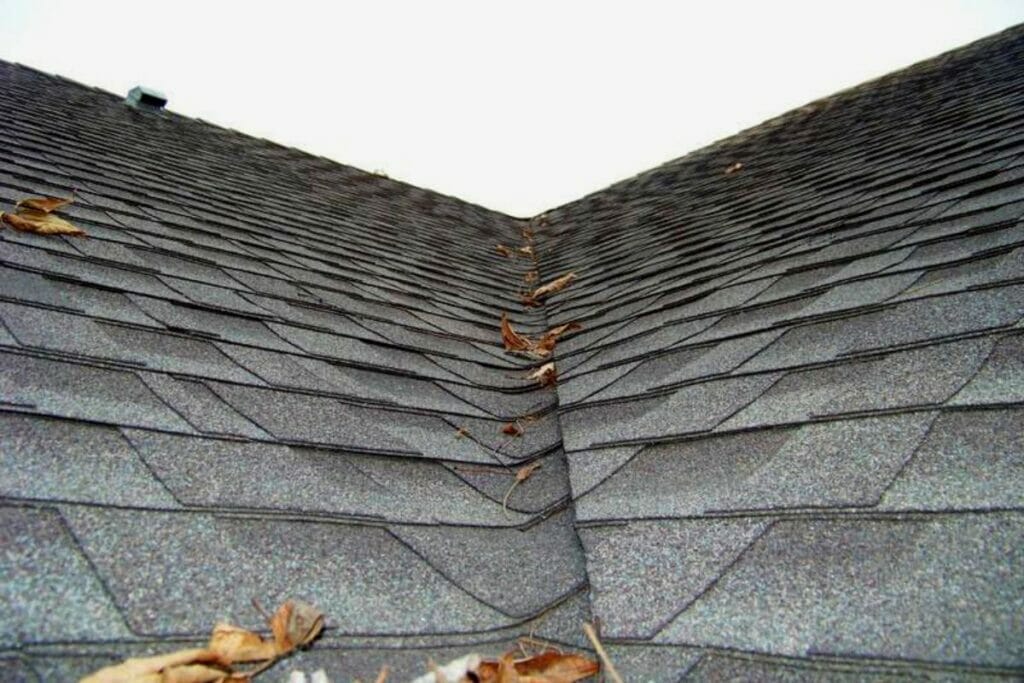
A closed valley roof refers to a type of roofing system in which flashing material is not installed along the roof valley. Instead, the valley is closed by overlapping shingles with felt underlayment underneath. These shingles are arranged in a curved or pointed shape so that water can smoothly slide down the shingles without pooling.
Advantages Of A Closed Roof Valley
Closed roof valleys have just one or two advantages open roof valleys. However, they can be a good option for some homeowners. Here’s what you need to know about the pros and cons if you’re considering having a closed roof valley.
Easy On The Wallet:
One of the biggest advantages of closed valleys is their cost-effectiveness. You don’t need additional flashing materials and labor, so the final cost of having a closed valley roof is slightly lower than it would be to install an open roof valley.
Harmonious Aesthetics:
Closed valley roofing provides a more natural look and blends seamlessly with the surrounding roofing materials. This helps create a more harmonious and aesthetically pleasing exterior for your home.
Disadvantages Of A Closed Roof Valley
If you live in a rainy or stormy region, closed roof valleys may have a higher number of disadvantages. Plus, it can also hamper the aesthetics of your home as it may make the roof look a little bland and compact.
Increased Maintenance:
Unfortunately, the lack of protective metal flashing along a closed valley also means that it is more susceptible to damage from the elements. This can result in the need for more frequent maintenance compared to open valley roofing, which could mean additional costs for the homeowner.
Risk Of Leaks:
Another drawback of a closed roof valley is the increased risk of leaks. Without metal flashing, water always runs straight over the shingles, causing granule loss, algae, and more damage to the area. When the shingles develop cuts and cracks, the water can easily penetrate the roof’s valleys and cause damage to the attic and interior of the home. This can lead to costly roof repairs if not addressed in a timely manner.
Longevity:
Closed valleys generally have a shorter lifespan than open valleys due to increased exposure to the elements and damage from wind and rain. They need more frequent repairs and replacements, which may exceed the overall cost of a closed valley roof.
Aesthetics May Not Be For Everyone:
While some homeowners may appreciate the harmonious look of a closed valley, others may find it too monotonous. Having no trim or contrast in this area may not appeal to some people.
Understanding Open Roof Valleys
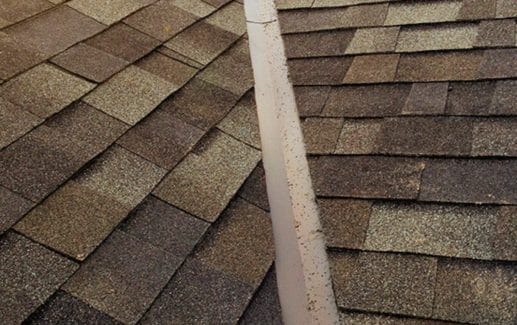
The name may be confusing, but open valleys are not really open. The roofing material or attic isn’t exposed, or left open, with this type of valley. Open valleys are called so because they are not enclosed by the same roofing material used throughout the roof. Instead, open valleys are protected by a different flashing material that paves the way for water to flow toward the gutters more easily.
Most roofing contractors suggest having an open roof valley so that water flows freely over the smooth path of metal flashing without causing damage to the inner layers of the roof. Here are the pros and cons of open roof valleys:
Advantages Of An Open Roof Valley
Open roof valleys are suitable for all types of homes. Whether you’re looking for interesting details, higher resale value, or better protection from water and other weather issues, open roof valleys can be an excellent option.
Increased Protection:
One of the biggest advantages of open valley roofing is the increased protection provided by the flashing material. This helps prevent damage from wind, rain, and snow, which can extend the lifespan of the roof and prevent costly repairs.
Reduced Maintenance:
The added protection from the flashing material means the roof valleys are less susceptible to damage and wear out at a slower rate than closed roof valleys. This usually results in a reduction in maintenance costs over time and less time spent on upkeep.
Improved Longevity:
Sturdy metal flashing made of aluminum, galvanized steel, or copper can stay strong for 20 to 50 years without frequent repairs or maintenance. However, you do have to clean the valleys if they are dirty or clogged with leaves.
Enhanced Aesthetics:
Metal flashing works as an added design element for the shingles or other roofing materials that cover the entire roof. The distinctive appearance of flashing is also often pleasing to the eye, especially if it’s made of copper or has a contrasting color.
Disadvantages Of An Open Roof Valley
In terms of cost and design, you should consider learning more about the design and material options available for open roof valleys. Some may like the look of it, while others may feel it costs more.
Higher Initial Costs:
Some flashing materials, like copper, may have a higher price tag. Also, some roofing contractors may increase their labor costs, as open valleys need more work and precision to install and secure roof flashing.
May Not Match Existing Aesthetics:
If you aren’t careful with the material or color of the flashing you choose, it may not match your home’s aesthetics or color combinations. Your roofing contractor or exterior designer can help you choose the suitable material and color for the valley flashing.
Hopefully, you should now have a better idea about the pros and cons of both types of roof valleys. Now, it’s time to figure out which one will be better for your home.
Open vs Closed Valley Roof: Which Is Right For Your Home?
First, think about the climate in your area. If you live in an area that receives heavy rainfall, strong winds, or snow, an open valley roof with metal flashing is the right option. The added protection can help to prevent the uplift of shingles and severe water damage. This will also extend the lifespan of your roof.
Second, consider the aesthetic appeal of your home. If you have an older home with a more rustic or natural aesthetic, closed valley roofing may complement such a look and feel. On the other hand, if you have a newer home with a more polished, finished look, open valley roofing can help you add more contrast and character to the roof.
Finally, consider your budget. There are different designs and materials to choose from. Each product has a different labor cost and material price. So you need to pick one that fits your home’s aesthetics as well as your budget.
If you want to learn more about your design options, we’ve provided an overview of different patterns and materials available for open and closed roof valleys.
Patterns & Materials Used For Roof Valleys
In this section, we’ve explained the most popular designs and materials that are used to cover roof valleys. You can discuss these looks with the professionals you hire for the job, and make a choice based on their expertise and your personal preferences.
Most Popular Closed Valley Designs
These valleys are closed by the same material which is used to cover the entire roof, such as asphalt shingles, slate slabs, and clay tiles. But there are different ways in which they can be installed.
Woven Valleys:
In this design, the roofers weave the shingles together to form a closely knit design. Woven valleys can provide a natural, rustic look that complements many older homes. However, this design requires more precision, labor, and time to install.
Cut Valleys:
In this, the roofers cut the shingles and install them in a V or W shape to cover the valleys. This creates a more uniform look with no dramatic contrast. This is also easier and less costly to install than the woven system.
Most Common Flashing Material For Open Valleys
Metals like aluminum, steel, and copper are the most common materials used to cover open roof valleys.
Aluminum:
Aluminum is the most popular choice for valley flashing due to its many benefits, such as being lightweight, low cost, and having incredible resistance to corrosion. Aluminum is also highly durable, but it may not be as durable as copper. This metal is best for coastal states, where there’s a high amount of salt in the atmosphere.
Copper:
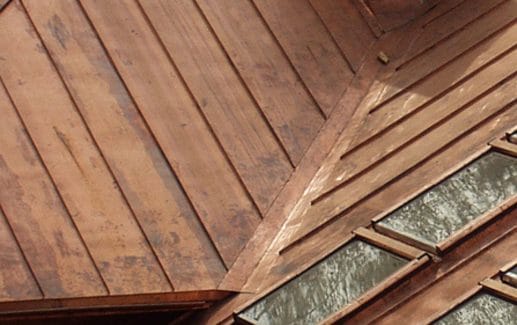
Copper is a high-end option for valley flashing known for its resistance, beauty, and durability. Copper valley flashing costs more than other materials, but it is more cost-effective in the long run, as it can last about 50 years! Copper is best for rainy states like Pennsylvania.
Steel:
Pure steel is the cheapest option but is prone to rust. In most cases, steel flashing is always coated with zinc or aluminum to help with water resistance. This option is better for mild climates where sunshine or high winds are more dominant than floods, rain, or snow, like in California and New Mexico.
If you live in Pennsylvania, we can help you select the best roofing style and materials, so you don’t have to face the common roof valley problems. So reach out to us for expert guidance and installation services.
Get A Free Consultation & Estimate From Our Experts
Making the right roofing decision, especially with your roof valley design, can be confusing. Luckily, with the team at North Star Roofing by your side, you can rest assured that your roofing needs will be taken care of with precision and professionalism. We understand the importance of having a home that not only looks good but also offers maximum protection for decades! That’s why we offer free consultations and estimates, so you can make a decision you’re confident in. Our experts will take the time to listen to your unique roofing requirements and provide you with a fair estimate.
Call us at (484)-302-7663 for free advice and an estimate of the cost to repair your roof valley or install a new one. Let us ease your mind and make your roofing project a stress-free success!
